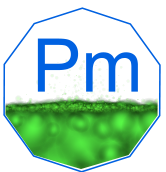Promethium

Promethium (Pm)
General Information
- Symbol: Pm
- Atomic Number: 61
- Atomic Weight: [145] u
- Element Category: Lanthanide
- Group: N/A (Lanthanides series)
- Period: 6
- Block: f-block
Physical Properties
- Appearance: Metallic, silvery-white
- Density: 7.26 g/cm³
- Melting Point: 1042 °C (1908 °F)
- Boiling Point: 3000 °C (5432 °F)
- Phase at STP: Solid
- Electron Configuration: [Xe] 4f⁵ 6s²
- Oxidation States: +3 (most common)
Chemical Properties
- Reactivity: Promethium is quite reactive, forming a protective oxide layer in air. It reacts with acids to form promethium salts and with water to form promethium hydroxide.
- Compounds: Forms compounds such as promethium(III) oxide (Pm₂O₃), promethium(III) chloride (PmCl₃), and promethium(III) nitrate (Pm(NO₃)₃).
Uses and Applications
- Nuclear Batteries: Used in atomic batteries to provide power for space probes, pacemakers, and other devices requiring a long-lasting power source.
- Phosphorescent Paints: Promethium phosphorescence can be used in self-luminous paint for watches and instrument dials.
- Research: Used in various research applications, particularly in studying the properties of lanthanides and radioactive elements.
Occurrence and Extraction
- Natural Occurrence: Promethium does not occur naturally in significant amounts; it is typically found in trace amounts in uranium ores.
- Extraction: Produced artificially in nuclear reactors through the fission of uranium-235 or plutonium.
Isotopes
- Stable Isotopes: Promethium has no stable isotopes.
- Radioactive Isotopes: Promethium-145 (most stable with a half-life of 17.7 years), Promethium-147 (half-life of 2.62 years)
Safety and Handling
- Hazards: Promethium is highly radioactive and poses significant health risks due to its intense radioactivity. It can cause radiation burns and increase the risk of cancer.
- Precautions: Handle with extreme caution using specialized protective equipment and facilities designed to contain radioactivity. Promethium is typically handled in very small amounts under controlled conditions in research laboratories.
History
- Discovery: Discovered by Jacob A. Marinsky, Lawrence E. Glendenin, and Charles D. Coryell in 1945.
- Name Origin: Named after Prometheus, a figure from Greek mythology who stole fire from the gods and gave it to humanity, symbolizing the element’s potential for power.
Additional Facts
- Crystal Structure: Hexagonal close-packed (hcp)
- Magnetic Properties: Paramagnetic
- Thermal Conductivity: 17.9 W/m·K
- Electrical Resistivity: 0.75 µΩ·m at 20°C
Summary
Promethium is a synthetic, highly radioactive lanthanide with a range of applications in industry and technology. It is particularly valuable in nuclear batteries and research. Discovered in 1945, promethium is named after the Greek mythological figure Prometheus. Promethium does not occur naturally in significant amounts and is typically produced in nuclear reactors. Due to its radioactivity and health risks, it requires specialized handling and is studied in controlled laboratory environments.
40 Question and Answer Pairs About Promethium
What is the atomic number of Promethium?
- 61
What is the symbol for Promethium?
- Pm
What is the atomic weight of Promethium?
- [145] u
In which group of the periodic table is Promethium found?
- Lanthanides series (no specific group)
What period is Promethium in?
- Period 6
What block does Promethium belong to?
- f-block
What is the density of Promethium?
- 7.26 g/cm³
What is the melting point of Promethium?
- 1042 °C (1908 °F)
What is the boiling point of Promethium?
- 3000 °C (5432 °F)
What is the electron configuration of Promethium?
- [Xe] 4f⁵ 6s²
What are the common oxidation states of Promethium?
- +3 (most common)
What is the appearance of Promethium?
- Metallic, silvery-white
Is Promethium reactive with air?
- Yes, it forms a protective oxide layer.
Name a compound of Promethium.
- Promethium(III) oxide (Pm₂O₃)
What is a common use of Promethium in batteries?
- In atomic batteries for space probes and pacemakers.
How is Promethium used in the paint industry?
- In phosphorescent paints for self-luminous watches and instrument dials.
What role does Promethium play in research?
- Used to study the properties of lanthanides and radioactive elements.
How is Promethium typically found in nature?
- In trace amounts in uranium ores.
How is Promethium produced?
- Artificially in nuclear reactors through the fission of uranium-235 or plutonium.
What is the most stable isotope of Promethium?
- Promethium-145
What is the half-life of Promethium-145?
- 17.7 years
What safety hazard is associated with Promethium?
- It is highly radioactive and poses significant health risks.
Who discovered Promethium?
- Jacob A. Marinsky, Lawrence E. Glendenin, and Charles D. Coryell
Where does the name Promethium come from?
- Named after Prometheus, a figure from Greek mythology.
What is the crystal structure of Promethium?
- Hexagonal close-packed (hcp)
Is Promethium paramagnetic or diamagnetic?
- Paramagnetic
What is the thermal conductivity of Promethium?
- 17.9 W/m·K
What is the electrical resistivity of Promethium at 20°C?
- 0.75 µΩ·m
What is the primary oxidation state of Promethium in its compounds?
- +3
Is Promethium found as a free element in nature?
- No, it is typically found in trace amounts in uranium ores.
What is the common name of Promethium(III) nitrate?
- Pm(NO₃)₃
What is a major application of Promethium in batteries?
- Atomic batteries for long-lasting power sources.
How does Promethium benefit the paint industry?
- Used in phosphorescent paints for self-luminous watches and instrument dials.
What is the melting point of Promethium in Kelvin?
- 1315 K
What group does Promethium belong to in the periodic table?
- Lanthanides series
What is the natural abundance of Promethium-145?
- It is a synthetic isotope with no natural abundance.
Can Promethium be used in high-temperature applications?
- No, due to its radioactivity and health risks.
What is the key property that makes Promethium valuable in nuclear batteries?
- Its ability to provide long-lasting power.
How is Promethium used in the chemical industry?
- Mainly in research to study radioactive properties.
What precautions should be taken when handling Promethium?
- Use specialized protective equipment and facilities to contain radioactivity.






